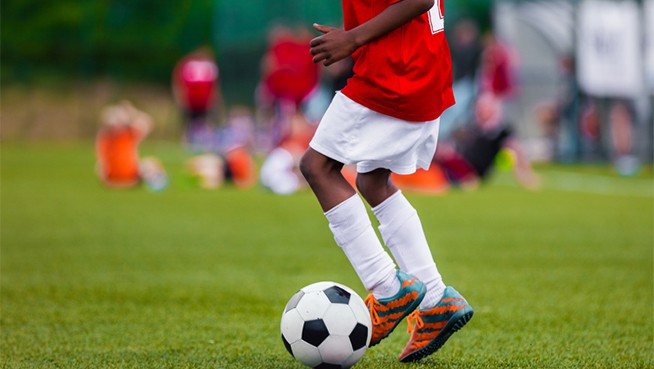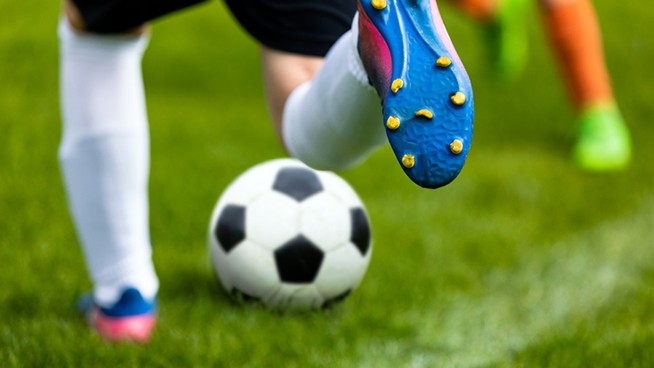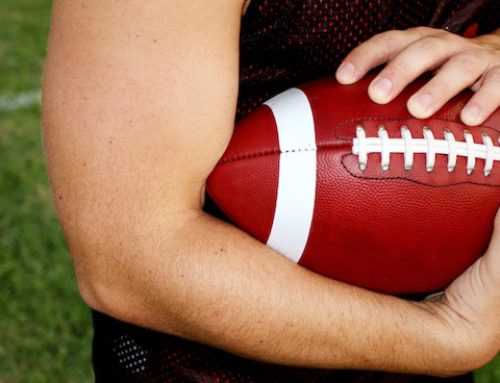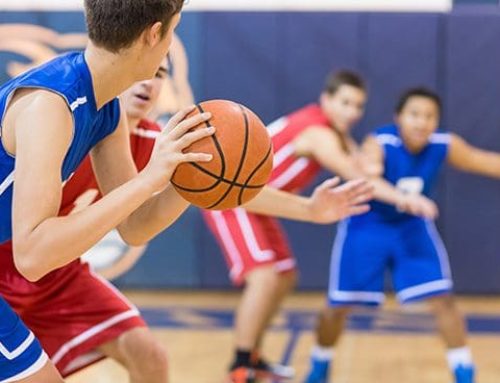Your Eyes Could Be Killing The Effectiveness of Your Training. Here’s How to Fix It
Vision.
It’s one of the most underrated components of athletic performance. Can you imagine a blindfolded LeBron James or Tom Brady trying to lead their respective teams to victory? Of course not. Yet visual awareness is rarely a consideration during many training programs. This leads to an all-too-common phenomenon—athletes looking down at their own feet during certain drills and exercises. Sometimes, it’s for an added sense of balance and stability. Other times, it’s for re-assurance their feet are going in the right place. But no matter the cause, it’s a critical flaw that can hinder an athlete’s ability to translate their training into better athletic performance.
“Barry Sanders, Michael Jordan, Rickey Henderson, Mia Hamm and Wayne Gretzky all demonstrated a great sense of both quickness and visual awareness while playing their respective sports. Their ability to move in space and see things unfold around in real time was a significant contributing factor to their success,” says John Mikula, MA, CSCS, and owner of Tactical Speed and Strength. “I wonder how many of them practiced kinesthetic-based strength movements and agility drills while staring at their feet?”
Barry Sanders might’ve had the most exceptional vision of any athlete in history. The former NFL running back consistently eluded defenders thanks not only to his remarkable speed and agility, but to his eyes. Sanders was a master at surveying the field around him mid-play to find creases and cutback lanes and leave would-be tacklers grabbing air. Watch his highlights and note how active his eyes are. “Your eyes aren’t going to lie to you,” Sanders told Sports Illustrated in 1994. “You have to see it and react to what you see.”
It sounds stupidly simple, yet the eyes have seemingly fallen by the wayside in many sports performance training programs. The number one goal of athletic training is to safely enhance performance during competition. In team sports, being acutely aware of the positioning of yourself, your teammates and your opponents is absolutely critical to success.
“Bring into focus the work athletes do on balance training, single-leg strength training, plyometrics and agility to promote movement-based body awareness and stability applied to the ground. Now, where often is the visual focus while doing this type of training? Staring at the feet,” Mikula says. “It’s really kind of a no-brainer—if an athlete has their head staring down at their feet, we’re off track.”
Mikula contends that we should approach dysfunctional eyeline and head position the same way we do compensatory movement patterns, such as the knees collapsing inward during a Squat. It’s simply easier for many athletes to stay balanced while staring at a fixed point, and the ground is about as fixed as it gets. But an athlete shouldn’t get used to staring at the ground during training if they don’t want to be staring at the ground during a game.
“Staring at a fixed point will help your balance as you perform standing exercises, but it will not improve your sporting performance if your sport requires that you have to move your head and eyes,” writes physiotherapist Joanna Elphinston in her book, Stability, Sport and Performace Movement: Great Technique Without Injury. The easiest way to help an athlete overcome a compensation is by regressing a drill or exercise, and eyeline and head position should be treated no differently.
One simple example is shortening the duration of speed ladder or cone drills. Marathon-length agility drills have become a hot trend in recent years. While these may look cool on social media, are they really translating to sport effectively? Mikula believes drastically shorter drills when an athlete can focus on a couple quick moves while remaining aware of their surroundings is a much better approximation of what occurs during competition. “Let’s shorten up those drills and make them a bit more realistic. One or two quick moves, not 10 or 20,” Mikula says. “We’re reinforcing the wrong things in many of those cases in my opinion.”
For single-leg standing exercises where stability and balance are essential, Mikula recommends similar regressions. If an athlete is struggling to keep their eyes up during Rear-Foot Elevated Split Squats, for example, regressing to Reverse Lunges is a good idea.
Reactive agility drills are a surefire way to ensure an athlete is keeping their head and eyes up during movement. A great example is the Dodgeball Agility Drill that NFL Pro Bowl running back Latavius Murray includes in his training routine:
If Murray’s eyes aren’t focused on what’s ahead of him during this drill, he’s dead meat. “Anything you have to react to pertains to the field more than anything. I don’t know where he’s going to throw the ball, I don’t know how he’s going to toss it, I don’t know how the ball will bounce. All those things are unknown. It’s as if you’re going against a defender—how’s he going to tackle you? You don’t know if he’s going to go low, if he’s going to go high. So I think (these drills) pertain to the field more than anything and these are the things that are going to help me,” Murray told STACK.
While specific visual training drills such as those done inside IMG’s Mind Gym are extremely beneficial, that’s not the focus here. The focus is simply getting athletes better acclimated to keeping their eyes and heads up during their traditional training routines.
“You are what you practice and reinforce,” Mikula says. “You’re moving in space, but your vision creates the sense that you can create plays. That’s what sets everything up. Strength and conditioning coaches need to see the bigger picture of training and work with athletes in a broader perspective of not only kinesthetic and proprioceptive awareness, but what’s also going in a visual sense concurrently. In other words, ‘keep your head up!’”
READ MORE:
RECOMMENDED FOR YOU
Your Eyes Could Be Killing The Effectiveness of Your Training. Here’s How to Fix It
Vision.
It’s one of the most underrated components of athletic performance. Can you imagine a blindfolded LeBron James or Tom Brady trying to lead their respective teams to victory? Of course not. Yet visual awareness is rarely a consideration during many training programs. This leads to an all-too-common phenomenon—athletes looking down at their own feet during certain drills and exercises. Sometimes, it’s for an added sense of balance and stability. Other times, it’s for re-assurance their feet are going in the right place. But no matter the cause, it’s a critical flaw that can hinder an athlete’s ability to translate their training into better athletic performance.
“Barry Sanders, Michael Jordan, Rickey Henderson, Mia Hamm and Wayne Gretzky all demonstrated a great sense of both quickness and visual awareness while playing their respective sports. Their ability to move in space and see things unfold around in real time was a significant contributing factor to their success,” says John Mikula, MA, CSCS, and owner of Tactical Speed and Strength. “I wonder how many of them practiced kinesthetic-based strength movements and agility drills while staring at their feet?”
Barry Sanders might’ve had the most exceptional vision of any athlete in history. The former NFL running back consistently eluded defenders thanks not only to his remarkable speed and agility, but to his eyes. Sanders was a master at surveying the field around him mid-play to find creases and cutback lanes and leave would-be tacklers grabbing air. Watch his highlights and note how active his eyes are. “Your eyes aren’t going to lie to you,” Sanders told Sports Illustrated in 1994. “You have to see it and react to what you see.”
It sounds stupidly simple, yet the eyes have seemingly fallen by the wayside in many sports performance training programs. The number one goal of athletic training is to safely enhance performance during competition. In team sports, being acutely aware of the positioning of yourself, your teammates and your opponents is absolutely critical to success.
“Bring into focus the work athletes do on balance training, single-leg strength training, plyometrics and agility to promote movement-based body awareness and stability applied to the ground. Now, where often is the visual focus while doing this type of training? Staring at the feet,” Mikula says. “It’s really kind of a no-brainer—if an athlete has their head staring down at their feet, we’re off track.”
Mikula contends that we should approach dysfunctional eyeline and head position the same way we do compensatory movement patterns, such as the knees collapsing inward during a Squat. It’s simply easier for many athletes to stay balanced while staring at a fixed point, and the ground is about as fixed as it gets. But an athlete shouldn’t get used to staring at the ground during training if they don’t want to be staring at the ground during a game.
“Staring at a fixed point will help your balance as you perform standing exercises, but it will not improve your sporting performance if your sport requires that you have to move your head and eyes,” writes physiotherapist Joanna Elphinston in her book, Stability, Sport and Performace Movement: Great Technique Without Injury. The easiest way to help an athlete overcome a compensation is by regressing a drill or exercise, and eyeline and head position should be treated no differently.
One simple example is shortening the duration of speed ladder or cone drills. Marathon-length agility drills have become a hot trend in recent years. While these may look cool on social media, are they really translating to sport effectively? Mikula believes drastically shorter drills when an athlete can focus on a couple quick moves while remaining aware of their surroundings is a much better approximation of what occurs during competition. “Let’s shorten up those drills and make them a bit more realistic. One or two quick moves, not 10 or 20,” Mikula says. “We’re reinforcing the wrong things in many of those cases in my opinion.”
For single-leg standing exercises where stability and balance are essential, Mikula recommends similar regressions. If an athlete is struggling to keep their eyes up during Rear-Foot Elevated Split Squats, for example, regressing to Reverse Lunges is a good idea.
Reactive agility drills are a surefire way to ensure an athlete is keeping their head and eyes up during movement. A great example is the Dodgeball Agility Drill that NFL Pro Bowl running back Latavius Murray includes in his training routine:
If Murray’s eyes aren’t focused on what’s ahead of him during this drill, he’s dead meat. “Anything you have to react to pertains to the field more than anything. I don’t know where he’s going to throw the ball, I don’t know how he’s going to toss it, I don’t know how the ball will bounce. All those things are unknown. It’s as if you’re going against a defender—how’s he going to tackle you? You don’t know if he’s going to go low, if he’s going to go high. So I think (these drills) pertain to the field more than anything and these are the things that are going to help me,” Murray told STACK.
While specific visual training drills such as those done inside IMG’s Mind Gym are extremely beneficial, that’s not the focus here. The focus is simply getting athletes better acclimated to keeping their eyes and heads up during their traditional training routines.
“You are what you practice and reinforce,” Mikula says. “You’re moving in space, but your vision creates the sense that you can create plays. That’s what sets everything up. Strength and conditioning coaches need to see the bigger picture of training and work with athletes in a broader perspective of not only kinesthetic and proprioceptive awareness, but what’s also going in a visual sense concurrently. In other words, ‘keep your head up!’”
READ MORE:










